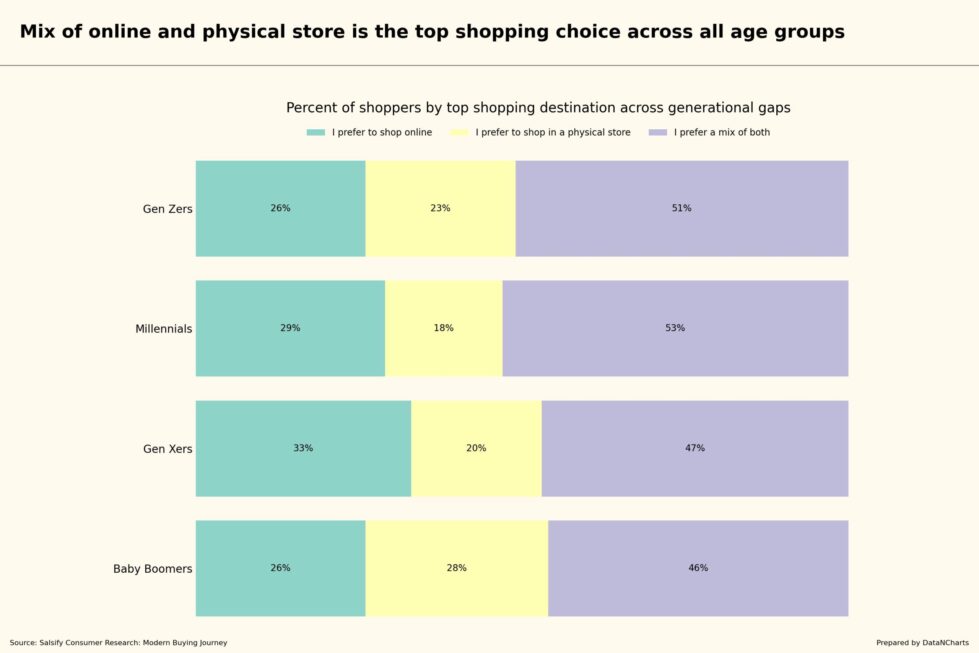Data Highlights
About half (53%) of Millennials prefer shopping both online and in-store.
Slightly over half (51%) of Gen Zers prefer combining online and physical shopping.
Nearly half (47%) of Gen Xers prefer mixed shopping methods.
Nearly half (46%) of Baby Boomers prefer a mix of online and physical stores.
One-third (33%) of Gen Xers prefer shopping exclusively online.
Over one-quarter (29%) of Millennials prefer online-only shopping.
One in four (26%) Gen Zers and Baby Boomers prefer shopping online.
One-quarter (28%) of Baby Boomers prefer physical stores exclusively.
About one in five Gen Zers (23%) and Gen Xers (20%) prefer shopping only in-store.
Millennials have the lowest preference (18%) for exclusively physical store shopping.
Scope
Shoppers increasingly prefer fluid experiences blending digital and physical channels. Current retail analytics reveal generational differences in consumer purchase patterns. This brief examines preferred shopping methods across generations. Readers will gain clear consumer behavior insights to effectively tailor their shopper marketing strategies and optimize the omnichannel shopping experience.
Millennials Lead the Mixed Shopping Trend (53%)
Millennials strongly prefer blending online and physical shopping. Over half (53%) regularly switch between channels during their shopper journey. Retailers must focus on seamless integration across platforms for this group. Brands clearly providing a unified shopper experience can capture more millennial buyers.
Gen Z closely follows Millennials with similar mixed-channel habits.
Gen Z Values Omnichannel Flexibility (51%)
Like Millennials, Gen Z shoppers favor shopping across both digital and physical platforms (51%). Digital consumer engagement heavily influences Gen Zers, yet they still visit physical stores to validate decisions. Retailers that offer consistent experiences across channels clearly meet Gen Z expectations, driving increased loyalty.
Gen X also favors mixed shopping, but many choose online-only.
Gen X Prefers Mixed, but Online Gains Ground (47% Mixed, 33% Online)
Gen X shoppers slightly prefer mixed-channel experiences (47%). Yet one-third (33%) clearly prefer shopping online exclusively. Convenience and efficiency dominate their consumer decision-making process. Retailers aiming at Gen X should optimize digital platforms clearly, making online shopping easy and reliable.
Baby Boomers similarly value mixed channels, yet physical shopping remains important.
Baby Boomers Remain Loyal to Physical Stores (46% Mixed, 28% In-Store)
Almost half (46%) of Baby Boomers prefer mixed-channel shopping, but nearly three in ten (28%) clearly favor physical stores. This generation values in-store shopper behavior, enjoying personal interactions and immediate product evaluation. Brands must maintain appealing physical store experiences clearly designed for Boomers.
Insights and Opportunities
Generational differences in shopping preferences provide clear insights for brands and retailers to effectively guide shoppers toward purchase.
- Firstly, retailers should focus heavily on omnichannel experiences, especially targeting Millennials and Gen Z. Implementing consistent and connected shopper experiences across channels clearly increases customer satisfaction and loyalty. Brands can expect improved repeat purchases, higher average order values, and stronger brand engagement. Measure success by tracking customer retention rates, average order values, and shopper satisfaction scores.
- Secondly, online experiences must meet Gen X expectations. Optimizing digital platforms through user-friendly navigation, clear pricing, and simple checkout clearly attracts and retains Gen X buyers. Retailers will see reduced cart abandonment, increased conversions, and greater customer satisfaction. Track improvements by analyzing online conversion rates, cart abandonment rates, and customer lifetime value (CLV).
- Finally, brands should tailor physical retail environments clearly to Baby Boomers' preferences. Comfortable, convenient store layouts, personalized assistance, and efficient checkout clearly attract and retain older shoppers. Retailers can anticipate increased in-store conversions, higher customer satisfaction, and improved loyalty. Use KPIs such as in-store conversion rates, average transaction size, and repeat visits to measure the impact.
By clearly aligning shopping experiences to generational preferences, brands can effectively guide consumers through their shopper path to purchase, driving increased sales and loyalty.
